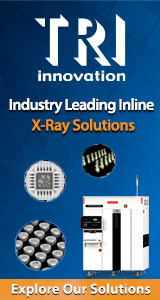|

|
|
| Ask the Experts | |||||||
|
|||||||
|
September 26, 2025 - Updated March 18, 2015 - Originally Posted Copper Dissolution RateDoes anyone have data on the rate of copper dissolution in solder? Have any studies been done on time/temperature and amount of copper. It's easy to claim that SnPb dissolves Cu but everybody has a different opinion on the rate and amount. B.W. |
|||||||
| Expert Panel Responses | |||||||
|
You're right... everyone seems to have a different number for the rate. This is because the test methods used vary so widely. There are multiple factors that affect the dissolution rate:
As an example, Hunt, et. Al (APEX 2009) reported a figure of 1.2um/s (0.047 mils/s)for SnPb solder at 255C, whereas my work with Denis Jean and Dale Lee reported at SMTAI 2006 found a rate of 0.89um/s (0.035 mils/s) for a temperature of 250C. Both rates were determined using foil dissolution from a PWB coupon,ours using a trace, and Hunt's using a pad. The rate differences found were most likely due mostly to flow, but also may have been influenced by foil type.
Process Engineer Astronautics Fritz's career in electronics manufacturing has included diverse engineering roles including PWB fabrication, thick film print & fire, SMT and wave/selective solder process engineering, and electronics materials development and marketing. Fritz's educational background is in mechanical engineering with an emphasis on materials science. Design of Experiments (DoE) techniques have been an area of independent study. Fritz has published over a dozen papers at various industry conferences.
The High Density Packaging Users Group(HDPug) has just completed a copper dissolution study. The final report is still being written but all data is collected. Potentially some of this data may be available to the industry.
Chairman of the IPC Technology Roadmap Committee Interconnect. Technology Analysis Inc. Jack Fisher is a retired IBM executive, chairman of the roadmap since 1994, and member of IPC Hall of Fame.
The testing is done by dipping a metal cylinder into an infinite amount of solder bath (no significant composition change). The radius reduction rate is used to indicate the dissolution of various elements in the solder bath. In real reflow process, the interfacial IMC growth and the solder joint composition variation due to surface material leaching may lead to a different behavior.
Technical Support Engineer Indium Corporation Kay Parker is a Technical Support Engineer based at Indium Corporation's headquarters in Clinton, N.Y. In this role she provides guidance and recommendations to customers related to process steps, equipment, techniques, and materials. She is also responsible for servicing the company's existing accounts and retaining new business.
Great question on the dissolution rate: I've listed a few places where information is available for you to research. The rate of dissolution is based upon a variety of parameters of which, is the Lead-Free alloy used, the temperature of the wave and the type of copper being dissolved be it either copper foil or electroplated copper for the plated through holes and such. See more info at:
Vice President, Technical Director EPTAC Corporation At EPTAC Corporation, Mr. Lambert oversees content of course offerings, IPC Certification programs and provides customers with expert consultation in electronics manufacturing, including RoHS/WEEE and lead free issues. Leo is also the IPC General Chairman for the Assembly/Joining Process Committee.
There are many factors which effect the rate of Cu dissolution such as solder flow rate, alloy type,copper type and of course soldering temperature and contact or dwell time. As stated it was known that SnPb did dissolve copper, although at a low rate, and with the introduction of SAC alloys to address RoHS it was found these alloys had a much higher rate of copper dissolution than SnPb. There has been several studies performed on copper dissolution especially in rework mini-wave applications. Hamilton and Snugovsky of Celestica and Kelly of IBM published a paper titled "A Study of Copper Dissolution During Lead Free PTH Rework Using a Thermally Massive Test Vehicle", SMTAi 2006 which shows the comparison between copper dissolution rates of SnPb,approximately 0.007mils/sec and SAC, approximately 0.035mils/sec for rework process soldering temperatures. It was also found for lead-free alloys, the SnCu nickel modified alloy, SN100C has a copper dissolution ratesimilar to SnPb. The paper can be found on the SMTA website, www.smta.org.
President FCT Assembly Mike Scimeca created FCT Assembly after the purchase of Fine Line Stencil, Inc., and consists of two major operations: stencil manufacturing and the manufacturing of electronic assembly products such as solder paste, flux and solder bar.
Reader Comment
Two additional references for this information would be:
Jasbir Bath, Koki Solder America
I am surprised nobody mentioned the original Bible for electronics soldering, Soldering in Electronics written by R.J. Klein Wassink. He was a pioneer in documenting not only the dissolution rates of nickel, copper, gold, silver, and many other noble metals and alloys into molten Sn63 solder, but covered a huge area of soldering for electronics. This book, along with the more modern papers documenting the same alloys into lead-free and other solders as listed by Mike Scimeca, would provide a complete listing on that topic. But start with Soldering for Electronics, you will be glad you did!
Advanced Engineer/Scientist General Dynamics Richard D. Stadem is an advanced engineer/scientist for General Dynamics and is also a consulting engineer for other companies. He has 38 years of engineering experience having worked for Honeywell, ADC, Pemstar (now Benchmark), Analog Technologies, and General Dynamics.
|
|||||||
| Submit A Comment | |||||||
|
Comments are reviewed prior to posting. You must include your full name to have your comments posted. We will not post your email address. |
|
Free Newsletter Subscription
Circuitnet is built for professionals who bear the responsibility of looking ahead, imagining the future, and preparing for it. Insert Your Email Address |
|

|






